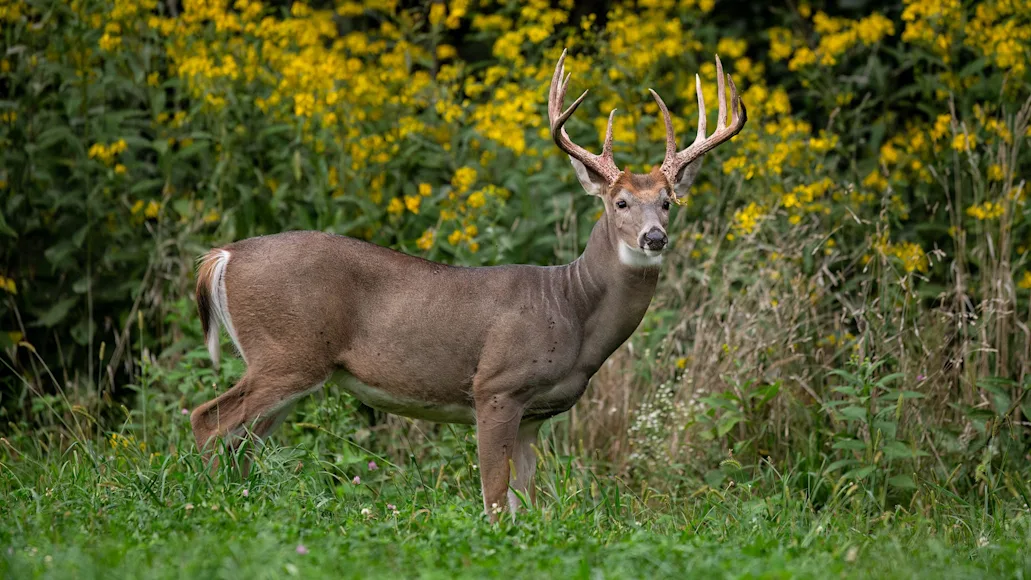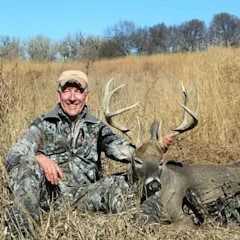ON A BITTER November afternoon, my neighbor Alan wrapped up his 15-year-old son, Tanner, like Ralphie’s kid brother in A Christmas Story, then put a muzzleloader in his hands and led him to a blind overlooking a cut cornfield. Though it was still early in the afternoon, they bumped a trio of does feeding in front of the blind before climbing in. Snow, pushed by a stiff breeze out of the northwest, dusted the smattering of cornstalks still standing around the hide and coated the tree limbs along the wood line just 30 yards off.
As Tanner settled into his chair and dug through his pack for handwarmers, his dad spotted two other does trotting through the timber. “They’re getting chased,” he whispered to Tanner. “Get your windows open and your gun ready.” Then, in one of those rare moments when exactly what a father predicts comes true before his child’s eyes, the does emerged from the woods, dragging behind them a wide-racked, bull-necked deer we called The Flyer.
I’m getting ahead of myself. This story doesn’t start in November. It starts in the early season.
First Impressions
I’ve long maintained that the first few weeks of the early archery season are the best time to tag a monster whitetail. Bucks are as unpressured as they’ll be all season, and most are following a basic bed-to-feed pattern that can be highly predictable. My three biggest bucks have all come in the month of September, and for years I’ve been preaching to those who don’t start hunting until the rut that they need get into the woods now for the chance to ambush a giant. But there’s another reason: Hunting September can make your November.
The Flyer is proof. A 5½-year-old mainframe 10 with a flyer point on one G2 and a bunch of other stickers, the buck was a regular on our trail cameras all through the late summer. When the early archery season opened in mid-September, Tanner’s dad, Alan, another neighbor and buddy, Dave, and I hunted and kept tabs on The Flyer all through September and October. None of us wrapped a tag on him, despite two months of effort, but what we learned in that time set the stage for Tanner’s rut hunt.
Close Encounter
On opening day of the Minnesota archery season, the thermometer on my porch read 90 degrees. I figured we’d skip hunting until things cooled off, but then Alan reminded me that we had pics of The Flyer hitting a certain alfalfa field in warm weather, so I drove him to a stand there with plans to pick him up after dark. It was a slow sit until the shadows lengthened, and then deer started filing into the feed, including a nice 8-point buck. Finally, with 20 minutes of shooting light left, The Flyer stepped out, spotted the smaller 8-point feeding 20 yards from Alan’s stand, and started marching toward him.
You could scour the woods looking for buck sign ahead of the rut, and no matter how much of it you found, it wouldn’t be as valuable as knowing where the does eat and sleep.
“You could see the gears turn in that buck’s head,” Alan told me later. “It was like, This is my field, and I want that spot. The two bucks sparred in easy bow range while Alan waited, at full draw, for The Flyer to turn broadside. But he never did. When the smaller buck broke off, The Flyer trotted after him, facing away the whole time.
But the hunt wasn’t a total loss. We learned some critical information about The Flyer. First, he wasn’t afraid to feed during daylight, even on a very warm day. Second, he acted like the dominant buck in the area—which meant that we were apt to see him again and that he was probably vulnerable to calling, rattling, or a decoy.
Putting It All Together
As we kept after The Flyer, trail-cam pics and occasional sightings mapped out his favorite feeding areas, including the alfalfa field and several smaller food plots in the surrounding timber. The fact that he was hitting them during the day told us that the buck was bedded nearby—and we didn’t need a map to tell us where.
A few years earlier, we hinge-cut a patch of junk timber that had grown up into a jungle of saplings, brush, and briars. When the chainsaws went quiet, we vowed not to hunt the spot in the hopes that area bucks would adopt the place as a sanctuary. It worked, and The Flyer was just the latest mature buck to move in. So long as we hunted only the fringes, and carefully, we knew he’d stick around.
Of course, we had plenty of early-season sits when we didn’t see The Flyer, or any other buck. But those hunts weren’t total busts either. They told us that there were plenty of does using the fields and plots surrounding The Flyer’s core area—and that he wouldn’t have to travel far to find mates come November. You could scour the woods looking for buck sign ahead of the rut, and no matter how much of it you found, it wouldn’t be as valuable as knowing where the does eat and sleep. And we now had that pegged.
That isn’t to say that buck sign is useless. It’s more like a bonus—nice if you get it—and with The Flyer, we got it. The first time I spotted the buck from the stand, he was heading toward a patch of cover I call the Runway, a narrow corridor of box elders connecting feeding areas where bucks historically love to put down sign. Sure enough, when I checked it the next day, I found a couple of fresh scrapes. I added two mocks nearby, hung a trail camera, and soon snapped pics of The Flyer chasing three does through the Runway.
Patience Pays
In truth, it would have been easy to give up on The Flyer. He had an annoying habit of pinballing from one part of the farm to another every few days. Had we not hunted him early, we probably would have chalked him up as one of those unpatternable rut bucks that you just hope to get lucky with. But we knew how faithful he was to his small core area, and that if we just kept hunting the periphery, even into the rut, one of us would get a chance.

Tanner Mote shows off The Flyer, taken with a muzzleloader during the heart of the Minnesota whitetail rut. Craig Johnson
That’s why Tanner was in the cornfield blind on that cold November day. He had the muzzleloader leveled before the three does trotted past, and when The Flyer presented a shoulder, he made the shot count. Soon he and Alan were standing over the giant buck we’d all been obsessing over since before opening day, and when the pictures hit Dave’s and my phone, we felt like we were a part of it, too.
You can kill a random monster in November, a buck you’ve never seen that suddenly shows up trolling for a mate. Nothing wrong with that. But it’s more satisfying to see a tag in the ear of a known giant that you’ve been after for months. And you can only do that if you start hunting him now.
_Read more F&S+
stories._






